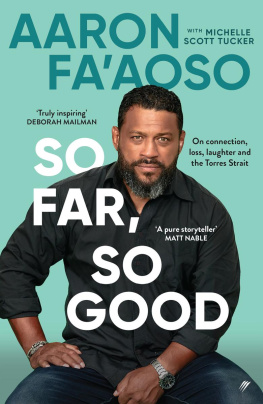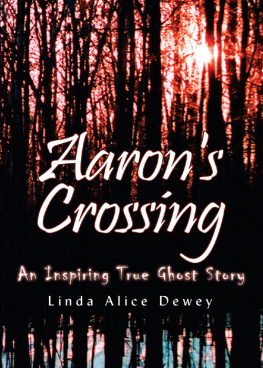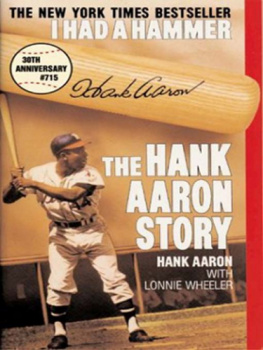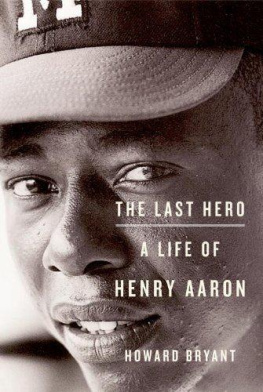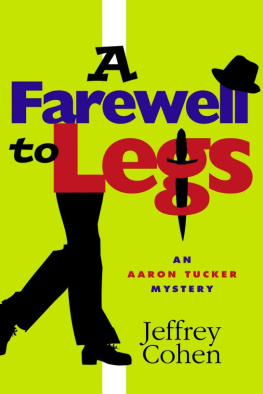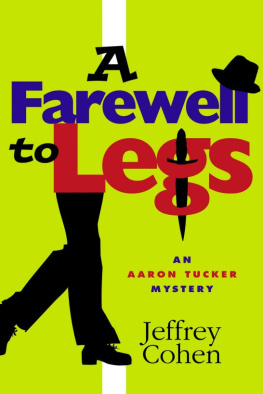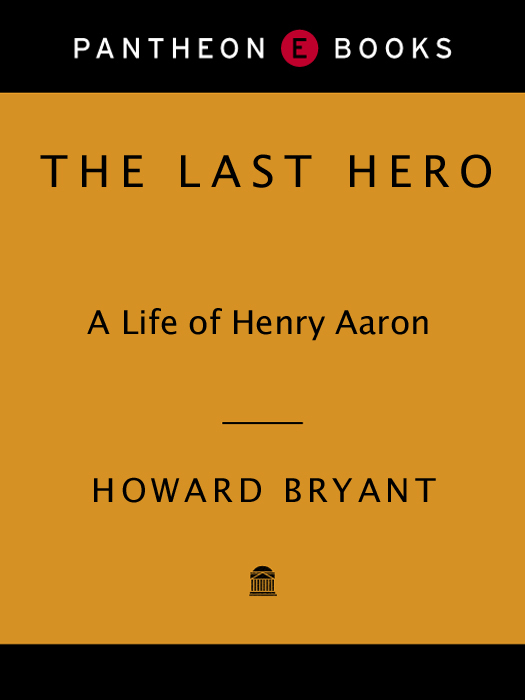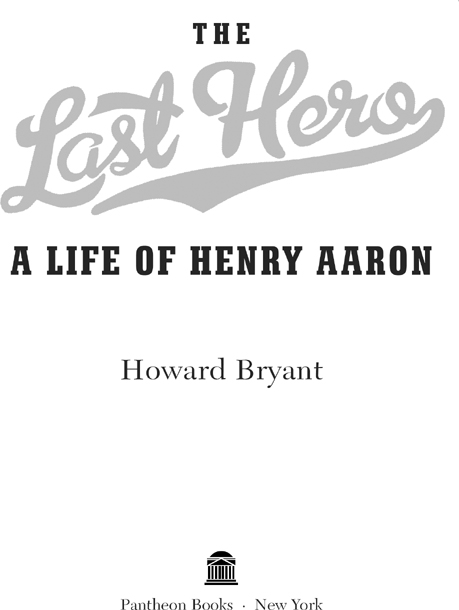ALSO BY HOWARD BRYANT
Shut Out: A Story of Race and Baseball in Boston
Juicing the Game:
Drugs, Power, and the Fight for the Soul of Major League Baseball
In memory of Nona Bryant,
and for Donald Bryant,
my parents
CONTENTS
PART ONE:
ONE:
TWO:
THREE:
FOUR:
PART TWO:
FIVE:
SIX:
SEVEN:
EIGHT:
NINE:
PART THREE:
TEN:
ELEVEN:
TWELVE:
THIRTEEN:
FOURTEEN:
FIFTEEN:
PART FOUR:
SIXTEEN:
SEVENTEEN:
EIGHTEEN:
INTRODUCTION
Nearing the crest of Manhattans Upper East Side, all Henry Aaron wanted was a milk shake. It was June, and the weather was humidan uncomfortable day gathering momentum toward oppressive.
Initially, the line out front wasnt much, just a couple of kids in baseball caps and shorts, holding baseballs and cellophane-protected glossies. Then it grew longer, sloping eagerly down Ninety-third street toward Second Avenue. New York had never been one of Henrys favorite cities, yet he had awakened on this particular Saturday at 4:00 a.m. so he could catch a 6:15 a.m. flight from Atlanta to La Guardia.
This autograph signing was the latest example of concept marketing: an event held in an upscale ice-cream parlor that doubled as a high-end memorabilia store. The idea that the upper-middle-class gentry from Westchester and North Jersey would spend their disposable income on mint chocolate chip cones and autographed three-hundred-dollar baseball jerseys was the brainchild of Brandon Steiner, the head of New York collectibles juggernaut Steiner Sports.
Inside the brightly colored, baseball-themed storefront sat Henry Aaron, seventy-four years old, in an air-conditioned back room across from clear plastic containers of Gummi Bears, Swedish Fish, and bobblehead dolls. Behind a folding table, Henry was flanked by candy and enough photographic evidence of his life to suggest a forensic exhibit.
There were black-and-whites from his high-flying days in Milwaukee, when he was all muscle and torque and potential; there were plastic blue-and-white batting helmets with the cursive letter A, for the Atlanta Braves, and pictures of when Hank hit a home run in the 1972 All-Star Game, played in Atlanta, the first major-league All-Star Game played in the Deep South. And there were snapshots of his jaunty, jowly American League finale, the career National Leaguer sporting the powder blue double knits of the Milwaukee Brewers.
Overwhelming it all were images from the night of April 8, 1974, at AtlantaFulton County Stadium. The images recorded that evening showed the follow-through from the batters box, when his eyes lit up, and the moment hed made impact. They showed the two kids catching up with him as he crossed the plate. They showed Joe Ferguson, the dumpy Los Angeles catcher, looking as though he were standing on the wrong subway platform. And they showed Hank Aaron holding up the historic ball returned to him by the teammate who had caught it, relief pitcher Tom House.
The line gathered outside and Henry girded. He knew it was time to reach into himself and get into character and become, once again, Hank Aaron. Each of the hundreds of photographs of the moment that had made him an international hero filled Henry with a special sense of dread.
This had been true for the last fifty-five years, this uneasy relationship. Inside, Aaron would do an in-store interview with ESPN Radio, trying to sound as though he actually cared about baseball in 2008, about which of todays players reminded him of himself (none!), and whether Yankee third baseman Alex Rodriguez could hit eight hundred home runs. (I dont get to see him much, Hank said, except in the play-offs and World Series.)
During a commercial break, a perky staffer filling a waffle cone promised Henry she would make him a milk shake. (Coming right up!) Henry stood up and stretched a bit while the eyes on himfrom the few dozen fans inside the store to the throng still waiting on the sidewalk, tapping on the glassbulged at the sight of him. They didnt yell, just stared at him, soaking in the deep creases of his face, the protruding belly, the white tennis shoes, and the limp, a souvenir from knee surgery that had left him on crutches for virtually the entire winter.
The ones who didnt speak tried to attract his attention with hand gestures and provocative clothing (a middle-aged woman sporting a Mets cap and cottage-cheese thighs, backpack slung over both shoulders, wore a T-shirt that read 755: THE REAL HOME RUN RECORD ). He smiled politely, wading easily through the crowd, unpretentiously close physically yet at a complicated emotional remove.
The words from the crowd solidified for him the idea that Hank was a necessary creation, a public conduit for his considerable fame, his tremendous ability, which had been sculpted into legend, and it was this distance, impossible to navigate, between what he represented to them and who he was, that Henry Aaron truly detested the most. The most obvious clue could be found in the name itself, for nobody who really knew him ever called him Hank. Well, almost nobody. Only one member of the inner circle, a kid Henry had met back in 1966, ever got away with calling him Hank. Henry had promised Johnnie and Christine Baker that he would take care of their son Dusty when he arrived in his first spring camp, and maybe that was why the rules were a little different for Dusty Baker.
To everybody else who mattered, he was Henry. Neither his first wife, Barbara, nor his second, Billye, ever called him Hank. As a boy, his name was Henry. That was what his mother and father and all seven siblings knew him by. His best friend from grade school, Cornelius Giles? To him, he was Henry. When hed first entered the big leagues a lifetime earlier, the name was how he differentiated the familiar, the friendly, from the rest. When he first came up, if you called him Hank, he wouldnt even hear you, recalled Billy Williams, who grew up close to Henry in Whistler, Alabama, a fingertips reach from Mobile. I remember we were in Chicago one day and everybody was yelling for him. They were screaming, Hank! Hank! and he just kept walking. Then, when everything died down, I said, Henry! and he immediately turned around. That meant you were a familiar face. That meant you knew him, and that was the only way hed ever turn around.
The adorning of him as the peoples champion (Youre still the home run king, Hank!) did not evoke a response. He did not respond to the dozen offhanded variations of the same themethe Barry Bonds question. It was the publics way to broach the unspeakable, and by his total lack of reaction, you would have thought the numbers that used to define him714, 715, and 755as well as the names of Mays, Ruth, and Bonds, were by now just street noise to him.
The names and iconic statistics are, of course, much more than that and the oceanic space between the public Hank, who avoids confrontation, and the private Henry, who is clear and passionate and committed, explain why he can never do enough or say enough to satisfy supporters thirsty not only for his statesmanship but his fire. Bonds was where the collision between Hank and Henry was often the fiercest, where the facade came closest to dissolution. It was Hank, the public man, the legend, who wished Barry well in his quest to break the all-time home run record, who avoided controversy. It was Hank Aaron who publicly drove down the avenue of gracious clich. Records were made to be broken, he would say. He had enjoyed his time as the record holder, and now it was time for someone else to take over.




